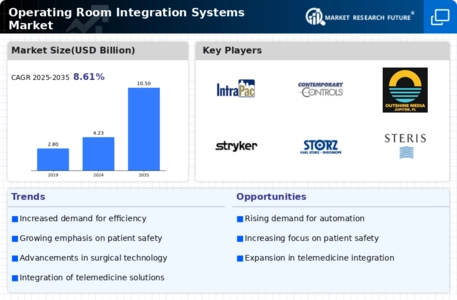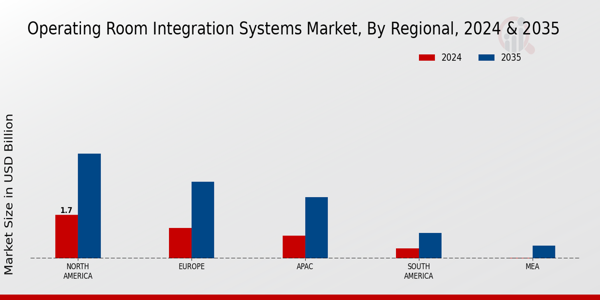Market Share
Operating Room Integration Systems Market Share Analysis
Operating room integration systems have become an essential component of modern healthcare facilities, revolutionizing the way surgical procedures are conducted and managed. The convergence of advanced technologies, streamlined workflows, and optimized information flow within operating rooms has marked a transformative shift in healthcare delivery.
One of the pivotal factors driving the adoption of integrated operating room systems is the evolving landscape of reimbursement policies. In many countries, such as Australia, the healthcare system has witnessed a significant shift towards more inclusive reimbursement policies. Medicare, for instance, played a crucial role by providing free treatment to patients in public hospitals. This initiative significantly expanded access to healthcare services, with a vast majority of the population benefiting from over 368 million individual services under the Medicare Benefits Schedule from 2014 to 2015. These inclusive policies have catalyzed a surge in patient volumes opting for sophisticated and often expensive surgical procedures.
The ripple effect of these policies has been profound. The surge in patients seeking advanced treatments has directly influenced the demand for more efficient and technologically sophisticated surgical interventions. Consequently, healthcare facilities are increasingly investing in integrated operating room systems to meet the growing demand for enhanced surgical precision, streamlined workflows, and optimized patient outcomes. This surge in demand is not only reshaping healthcare practices but also propelling market growth in the field of integrated operating room management systems.
Moreover, the benefits derived from streamlined information flow and reduced congestion within operating rooms are reshaping the landscape of surgical environments. Operating rooms, by their very nature, demand a highly focused and efficient environment. Yet, without the integration of operating room functionalities, surgical teams often grapple with disparate systems and fragmented information access. These scenarios result in unnecessary interruptions, consuming valuable time and diverting attention from the primary focus—patient care.
The integration of operating room functionalities resolves these challenges by consolidating critical patient data onto a unified platform accessible to the entire surgical team. This integration minimizes disruptions, reduces congestion, and optimizes information flow. As a result, it significantly enhances the efficiency and safety of surgical procedures. The centralized control and streamlined workflows offered by these integrated systems not only bolster productivity but also elevate the overall standard of patient care, positioning these systems as indispensable components of modern healthcare infrastructure.
Furthermore, the significance of integrated operating room systems extends beyond the realm of immediate patient care. These systems serve as catalysts for increased operational efficiency within healthcare facilities. By optimizing the flow of information and consolidating disparate systems, these integrated solutions pave the way for smoother coordination among surgical teams. This level of streamlined communication and data accessibility not only ensures better decision-making during surgeries but also contributes to a more synchronized and efficient healthcare ecosystem.
The evolving landscape of reimbursement policies and the consequent surge in patient volumes seeking advanced surgical interventions have propelled the adoption of integrated operating room management systems. These systems not only streamline information flow and reduce congestion within operating rooms but also serve as pivotal tools in enhancing the overall efficiency, safety, and quality of patient care. As healthcare facilities continue to embrace these integrated solutions, the trajectory of market growth in the domain of operating room integration systems is poised to remain robust, fostering a new era of technologically advanced and patient-centric healthcare delivery.














Leave a Comment